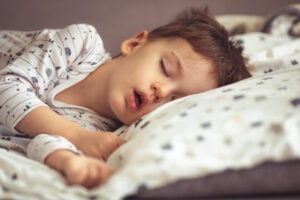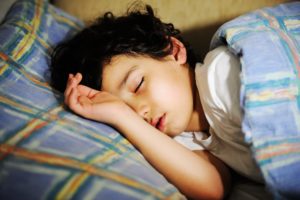When you buy through our links, we may earn a commission. Products or services may be offered by an affiliated entity. Learn more.
Bedwetting and Sleep
Bedwetting is a familiar problem many people experience at some point. Still, bedwetting can be uncomfortable and upsetting for both children and parents, especially when it happens in older children. If this sounds familiar, you’re not alone.
What Is Bedwetting?
Bedwetting, also called “nocturnal enuresis,” is involuntary urination during sleep in children over five years of age. Bedwetting affects five to seven million children in the US and 5 to 10% of all seven-year-olds. Although bedwetting is slightly more common in boys than in girls, it affects children of all genders.
When Is Bedwetting a Problem?
Bedwetting can be expected in young children, but it becomes less common and less frequent with age. Rates of bedwetting in children generally drop noticeably around age five, with only 1% of this group wetting the bed nightly. Twenty percent of five-year-olds wet the bed at least once per month, even after they are otherwise potty trained. By adulthood, less than one percent of all people wet the bed at least once per month.
Since each child matures and hits developmental milestones at a different pace, different children stop wetting the bed at different ages. Generally, occasional bedwetting is considered normal in childhood and is nothing to worry about.
- In rare cases, bedwetting indicates an underlying problem. Parents might want to explore medical testing if their children experience any of the following issues :
- Sudden onset of bedwetting episodes in older children or teenagers after a long period of dry sleeping
- Painful urination
- Cloudy or discolored urine
- Daytime incontinence
- Bowel movement issues, such as constipation or a lack of bowel control
- Sleep issues, such as being unable to be woken up
- Excessive thirst
Help Your Child Sleep Better With Pediatric Sleep Coaching

our partner at sleepdoctor.com
Learn More“Life-changing! My anxiety about my son’s sleeping habits were immediately reduced after talking to Sara. She went above and beyond to tailor a schedule to our goals, answer our questions, keep us on track, and check in to encourage us when we just thought we couldn’t do it anymore.”
Rachael B. – Verified Customer
Potential Causes of Bedwetting
Most bedwetting is normal and doesn’t have any underlying cause. That said, there are a wide range of potential causes that can lead to bedwetting. They include:
- Anxiety: Research shows that children who experience bedwetting are significantly more likely to have anxiety issues than children who do not wet the bed. Anxiety can be the result of a chronic, ongoing state of distress or a direct response to a specific stressful condition or event. Children who struggle with bedwetting are more likely to experience generalized anxiety, panic attacks, school phobia, social anxiety, and separation anxiety. If bedwetting is a persistent issue, parents might want to consider having their child checked for an anxiety disorder.
- Eating and drinking habits: Certain foods and drinks are diuretics, which means that they cause the body to produce more urine. Some children are more sensitive to diuretics than others. Caffeine, especially that found in coffee and tea, is a major diuretic. Also, when a child drinks can impact how likely they are to wet the bed. For this reason, many parents restrict their children’s fluid intake in the evening as bedtime nears.
- Urinary Tract Infections (UTIs): Sometimes, children wet the bed because they have a urinary tract infection , or UTI. Common symptoms of a UTI include frequent and unexpected urination, as well as inflammation of the bladder, both of which can cause bedwetting. Though UTIs are easily treatable, they often go initially undiagnosed in children, who sometimes lack the ability to explain their symptoms.
- Sleep apnea: Sleep apnea causes the body to repeatedly stop breathing during sleep. It is relatively common among adults, but recent research has shown that it is found in children as well. One potential effect of sleep apnea is the production of a hormone called “atrial natriuretic peptide” (ANP). ANP causes the kidneys to produce extra urine during sleep, which may lead to bedwetting .
- Constipation: Constipation causes excess waste to accumulate in the rectum, which can make it bulge. The rectum is located right behind the bladder, so in some cases, a bulging rectum pushes on the bladder. As a result, regular constipation can cause bedwetting. Children experiencing both constipation and bedwetting should treat constipation first, then see if the bedwetting subsides.
In addition, certain factors increase the risk of bedwetting, especially in children. These include family history, having ADHD, or being a “deep sleeper.”

How Bedwetting Affects Sleep
There are many ways in which bedwetting can affect sleep. For one, wetting the bed can cause a child to wake up, which often leads to a prolonged sleep disruption while they either clean themselves up or get a caretaker to help clean them up. It can often be difficult to fall back asleep after this sort of nighttime disruption.
In addition, struggling with bedwetting can cause psychosocial problems. For example, children might feel anxiety around bedtime, which can make it more difficult to fall asleep. Bedwetting can also lead to feelings of shame and depression, as well as social embarrassment, which can affect a child’s emotional wellbeing and lead to further sleep difficulties.
Finally, some cases of chronic bedwetting can cause rashes and irritation from exposing the skin to urine, which can lead to discomfort that can further affect sleep.
Tips To Stop Bedwetting
Addressing a bedwetting problem may seem daunting at first, but it’s often much less complicated than it seems. There are a wide variety of actions you can take to help get to the root of most bedwetting issues. Try items on the list below to help your child reduce their bedwetting.
- Ask your child if something is wrong. It may sound obvious, but one of the best tools a parent has when it comes to bedwetting is communication. Ask your child if there is anything that is bothering them, or making them worried, angry, or sad. If you know that something has been upsetting your child lately, or know that they are going through a significant change in their lives, ask how they are feeling about those things in particular. If the root of the bedwetting is emotional or psychological, this sort of conversation can help your child feel safe communicating with you about it. It’s also helpful to ask children about their bodies, with a focus on anything new that they might be experiencing. This can help identify a potential behavior to adjust or an underlying medical cause.
- Maintain a supportive attitude and steer clear of punishment. Most children who wet their beds are not doing it intentionally. Though bedwetting can be alarming and inconvenient to parents, it should not immediately be considered a behavioral issue or treated with punishment. Rather, it should first be considered an involuntary, relatively common developmental hiccup, and should be addressed compassionately and without anger or shame. Make sure to let your child know that you love, support, and empathize with them while discussing and dealing with bedwetting.
- Keep a calendar. Recording dry days vs. bedwetting days can help parents get a better sense of the problem and identify potential triggers. Parents can also keep a bedwetting calendar with their child, incorporating it into an incentive system for meeting milestones by providing rewards for one full dry night, week, month, etc. This is considered to be a form of behavioral therapy. Some children are positively motivated by visually tracking their progress, and by earning rewards when they reach goals.
- Improve sleep hygiene. Many sleep-related problems can be helped with the improvement of “sleep hygiene.” Improving sleep hygiene means creating an environment and set of habits that facilitate a good night’s sleep. As with other sleep issues, improving sleep hygiene may improve nocturnal bladder control since bedwetting and poor sleep hygiene are related. Tips for improving sleep hygiene include having a regular wake-up time and bedtime, developing routines before bed, creating a comfortable, quiet sleep environment, and going screen-free for an hour before bedtime.
- Adjust daytime and nighttime drinking times. If possible, try to keep children from drinking for 1-2 hours before bed, so they will be less likely to need to urinate during the night. It’s also important to make sure your child stays hydrated and drinks regularly throughout the day, in order to avoid a “thirst overload” near bedtime.
- Adjust bathroom scheduling/habits. Make sure your child goes to the bathroom as close to bedtime as possible. It should be one of the very last things they do in their nighttime routine and may be repeated if necessary. In addition, schedule regular bathroom breaks throughout the day to keep your child’s kidneys and bladder healthy and help them pay attention to their bodies’ needs.
- Avoid bladder irritants. Some people believe certain foods and drinks cause the body to produce more urine, or irritate the bladder and reduce bladder control. Other experts advise against changing a child’s diet to manage bedwetting. If you think your child might be experiencing bladder irritation or excessive urination due to their diet, consult with your pediatrician before making any dietary changes.
- Biofeedback. Some studies suggest biofeedback could be a successful treatment for children who struggle with bedwetting. Biofeedback allows children to become more aware of their body’s physiological responses. The biofeedback process involves connecting a child to electromechanical equipment that notifies them of changes in bodily processes such as temperature, muscle tension, breathing, brain activity, and more.
- Pelvic Floor Exercises. Research shows pelvic floor exercises can successfully eliminate bedwetting in many children. Though more research needs to be done about this method, pelvic floor exercises are a potential solution to try when other treatments aren’t working.
- Use a wetness alarm. Wetness alarms work through a small sensor placed in a child’s pajamas or sheets. If the child starts to urinate, the sensor detects the moisture and the alarm goes off, ideally waking the child and giving them the chance to get to the toilet. When used over the course of time (usually around 12 weeks), the alarm can help train children to wake up naturally before they begin to urinate. A wetness alarm should only be installed if a child consents and understands the alarm’s purpose . Otherwise, it may only cause further humiliation, shame, and frustration.
- Ask your pediatrician. If your child continues to wet the bed, ask your pediatrician if there are potential underlying factors that you should be concerned about. In some cases, your pediatrician may run tests to rule out or identify underlying causes. Your pediatrician can also help you develop a bedwetting management plan that fits your child’s needs.

Still have questions? Ask our community!
Join our Sleep Care Community — a trusted hub of sleep health professionals, product specialists, and people just like you. Whether you need expert sleep advice for your insomnia or you’re searching for the perfect mattress, we’ve got you covered. Get personalized guidance from the experts who know sleep best.
References
14 Sources
-
Baird, D. C., Seehusen, D. A., & Bode, D. V. (2014). Enuresis in children: A case based approach. American Family Physician, 89(8), 560–568.
https://pubmed.ncbi.nlm.nih.gov/25369644/ -
Cohn, A. (2010). Recommended management of nocturnal enuresis in children. Prescriber, 21(8), 28-34.
https://wchh.onlinelibrary.wiley.com/doi/epdf/10.1002/psb.616. -
von Gontard, A., & Kuwertz-Bröking, E. (2019). The diagnosis and treatment of enuresis and functional daytime urinary incontinence. Deutsches Aerzteblatt International, 116(16), 279–285.
https://pubmed.ncbi.nlm.nih.gov/31159915/ -
Salehi, B., Yossefi Chiegan, P., Rafeei, M., & Mostajeran, M. (2016). The relationship between child anxiety related disorders and primary nocturnal enuresis. Iranian Journal of Psychiatry and Behavioral Sciences, 10(2), e4462.
https://pubmed.ncbi.nlm.nih.gov/27822271/ -
Caldwell, P. H. Y., Nankivell, G., & Sureshkumar, P. (2013). Simple behavioural interventions for nocturnal enuresis in children. Cochrane Database of Systematic Reviews, (7), CD003637.
https://pubmed.ncbi.nlm.nih.gov/23881652/ -
Kibar, Y. (2011). Current management of urinary tract infection in children. IntechOpen, 267–284.
https://www.intechopen.com/books/urinary-tract-infections/current-management-of-urinary-tract-infection-in-children -
Capdevila, O. S., Kheirandish-Gozal, L., Dayyat, E., & Gozal, D. (2008). Pediatric obstructive sleep apnea: Complications, management, and long-term outcomes. Proceedings of the American Thoracic Society, 5(2), 274-282.
https://pubmed.ncbi.nlm.nih.gov/18250221/ -
Tajima-Pozo, K., Ruiz-Manrique, G., & Montanes, F. (2014). Treating enuresis in a patient with ADHD: Application of a novel behavioural modification therapy. Case Reports, 2014(jun10 1), bcr2014203912.
https://pubmed.ncbi.nlm.nih.gov/24916977/ -
Anyanwu, O. U., Ibekwe, R. C., & Orji, M. L. (2015). Nocturnal enuresis among Nigerian children and its association with sleep, behavior and school performance. Indian Pediatrics, 52(7), 587–589.
https://pubmed.ncbi.nlm.nih.gov/26244952/ -
National Clinical Guideline Centre. (2010). Nocturnal enuresis: The management of bedwetting in children and young people. National Clinical Guideline Centre.
https://pubmed.ncbi.nlm.nih.gov/22031959/ -
American Academy of Pediatrics (AAP) Section on Integrative Medicine. (2016). Mind-Body therapies in children and youth. Pediatrics, 138(3), e20161896.
https://pubmed.ncbi.nlm.nih.gov/27550982/ -
Zivkovic, V., Lazovic, M., Vlajkovic, M., Slavkovic, A., Dimitrijevic, L., Stankovic, I., & Vacic, N. (2012). Diaphragmatic breathing exercises and pelvic floor retraining in children with dysfunctional voiding. European Journal of Physical and Rehabilitation Medicine, 48(3), 413–421.
https://pubmed.ncbi.nlm.nih.gov/22669134/ -
National Clinical Guideline Centre. (2010a). Enuresis Alarms in the management of bedwetting. In Nocturnal Enuresis: The Management of Bedwetting in Children and Young People (pp. 1–17).
https://www.ncbi.nlm.nih.gov/books/NBK62711/ -
Redsell, S. A., & Collier, J. (2001). Bedwetting, behaviour and self-esteem: a review of the literature. Child: Care, Health and Development, 27(2), 149–162.
https://pubmed.ncbi.nlm.nih.gov/11251613/





















